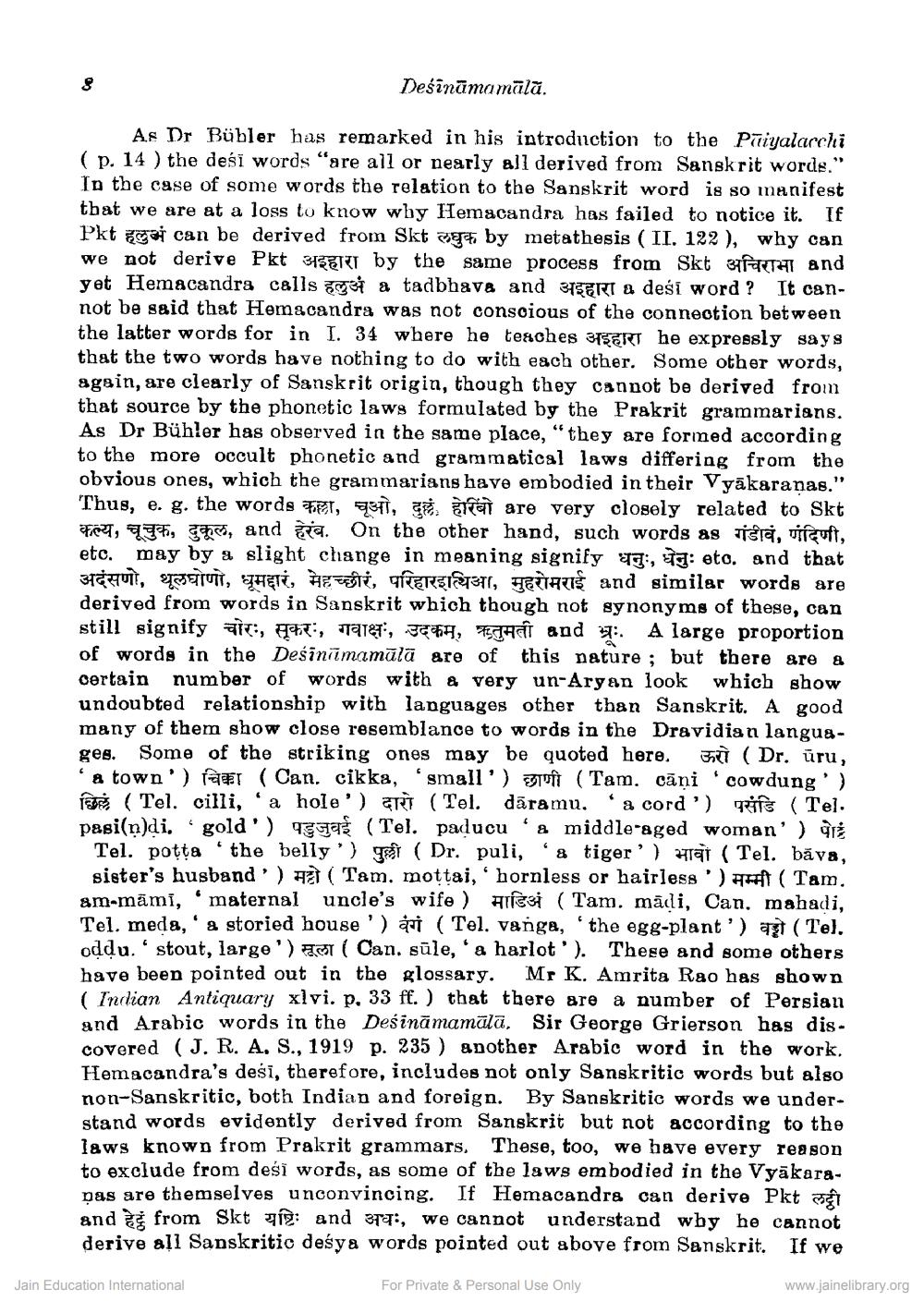________________
Dešināmamālā.
As Dr Bübler has remarked in his introduction to the Paiyalarchi (p. 14 ) the desi words “are all or nearly all derived from Sanskrit words." In the case of some words the relation to the Sanskrit word is so manifest that we are at a loss to know why Hemacandra has failed to notice it. If Pkt ga can be derived from Skt cerita by metathesis (II. 122 ), why can we not derive Pkt 31561 by the same process from Skt 37TH and yet Hemacandra calls si a tadbhava and 375Ert a desi word ? It cannot be said that Hem&candra was not conscious of the conneotion between the latter words for in I. 34 where he teaches 3156KT he expressly says that the two words have nothing to do with each other. Some other words, again, are clearly of Sanskrit origin, though they cannot be derived from that source by the phonetic laws formulated by the Prakrit grammarians. As Dr Bühler has observed in the same place, “they are formed according to the more occult phonetic and grammatical laws differing from the obvious ones, which the grammarians have embodied in their Vyākaranas." Thus, e. g. the words FET, 371, cat are very closely related to Skt Fe, 3", go, and a. On the other hand, such words as igre, vifcuft, etc. may by a slight change in meaning signify , : eto. and that B UT, SETT, ZHETI, Eti, qfERSTI, ETTATIS and similar words are derived from words in Sanskrit which though not synonyms of these, can still signify it:, :, Tate, 36H, Theft and 7 A large proportion of words in the Dešinimamālā are of this nature ; but there are a certain number of words with & very un-Aryan look which show undoubted relationship with languages other than Sanskrit. A good many of them show close resemblance to words in the Dravidian languages. Some of the striking ones may be quoted here. ( Dr. ūru, 'a town') e ( Can. cikka, 'small') yuf (Tam, căni cow dung') e Tel. cilli, a hole') art (Tel. dāramu. "a cord') gifs (Tel. pasi(n)di. gold') 39 (Tel. paducu & middle-aged woman') që
Tel. potta 'the belly') ( Dr. puli, '& tiger') 291 ( Tel. băva, sister's husband') FT ( Tam. mottai, ' hornless or hairless ') * ( Tam. am-māmi, 'maternal uncle's wife ) Alisi (Tam. mādi, Can, mahadi, Tel. meda, 'a storied house') & (Tel. vanga, 'the egg-plant') at (Tel. oddu.' stout, large') ( Can. süle, 'a harlot'). These and some others have been pointed out in the glossary. Mr K. Amrita Rao has shown ( Indian Antiquary xlvi. p, 33 ff.) that there are a number of Persian and Arabic words in the Deśināmamālā, Sir George Grierson has discovered (J. R. A, S., 1919 p. 235 ) another Arabic word in the work. Hemacandra's desī, therefore, includes not only Sanskritic words but also non-Sanskritic, both Indian and foreign By Sanskritic words we understand words evidently derived from Sanskrit but not according to the laws known from Prakrit grammars. These, too, we have every reason to exclude from desi words, as some of the laws embodied in the Vyakarapas are themselves unconvincing. If Hemacandra can derive Pkt og and from Skt gie: and 37:, we cannot understand wby he cannot derive all Sanskritic deśya words pointed out above from Sanskrit. If we
Reggae
Dr. Panornless
Jain Education International
For Private & Personal Use Only
www.jainelibrary.org




